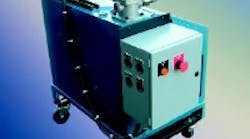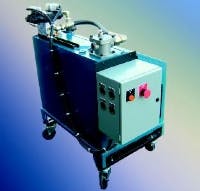As many plastic injection machine manufacturers move toward all-electric designs, there remains one very important part of the machine that continues to use 30-year-old technology — a "core pull/set" system. Approximately 30% of all machines use a core pull/set in the mold to achieve the desired cavity details. As the industry has accepted the new all-electric movement, the core pull system is sometimes an afterthought.
Most core pull systems use a traditional hydraulic pumping unit that is either dedicated to the machine or portable for use on any machine in a shop where core pulling is needed. These hydraulic power units usually require cooling water and a heat exchanger to maintain the hydraulic fluid at an acceptable temperature. The core pull unit only operates for 5 to 10 seconds per cycle; during the idle time, the electric motor continues to operate at full speed.
Whether the pressurized hydraulic fluid passes through a relief valve or a pressure-compensated pump is used, the pump and motor always rotate at full speed. This requires energy, which can sometimes equate to as much as 40% of full load current. Besides wasting valuable energy, this design also generates a significant amount of noise.
All World Machinery Supply, Harvard, Ill., offers a solution using Eco-Rich hydraulic power units. The basis of the technology is that motor speed is controlled by an electric inverter, so it rotates only fast enough to meet system demand. When the operating cycle calls for a dwell period, the motor automatically slows down to less than 400 rpm to maintain the desired pressure. Once a demand is sensed by an on-board pressure transducer, the motor accelerates to full speed in 0.1second. This is accomplished using a variable-speed motor drive design from Daikin, of Japan, which provides the Eco-rich HPUs.
These systems were originally designed for machine tools more than seven years ago. Many Asian manufacturers of CNC machinery are using this technology today with great success. As the product line evolved, larger units were designed for use in industrial hydraulic applications. One such application which has proven to be ideal is core pull/set systems on plastic injection molding machines.
The systems do not require cooling water, will save a measurable amount of energy and operate at a 60- TO 70-dBA noise level and are priced comparable to traditional hydraulic systems. Several plastic injection molding machine manufacturers have accepted this technology and offer the Daikin Eco-Rich systems for core/ pull set applications to their customers today. The Eco-Rich hydraulic systems deliver up to 22 gpm and are rated for pressure to 3,000 psi.
For more information, call (815) 943-9111 or visit www.allworldmachinery.com.


